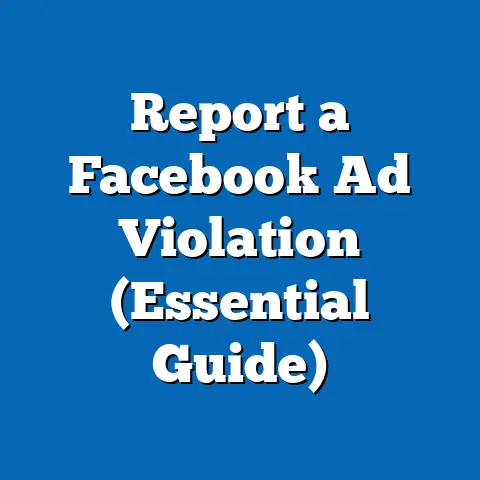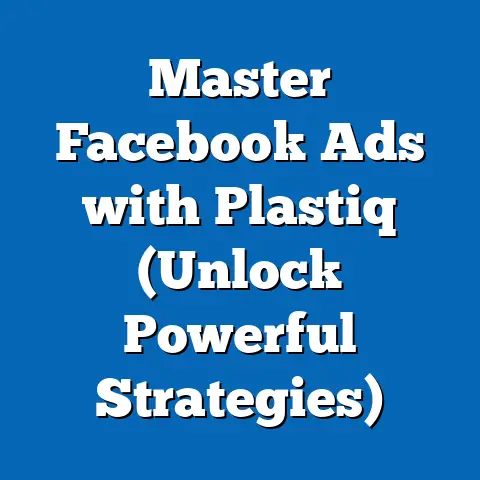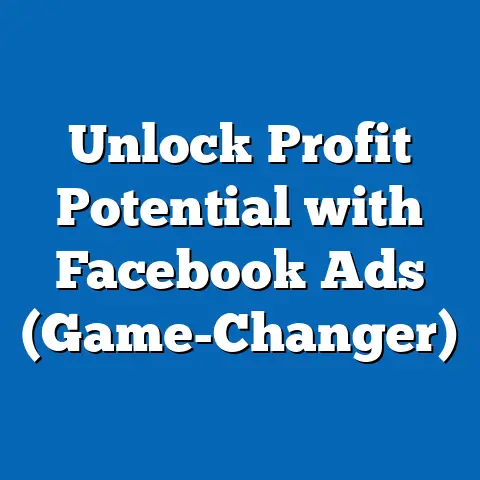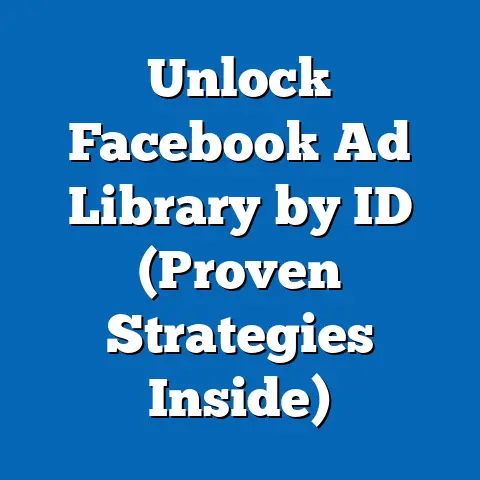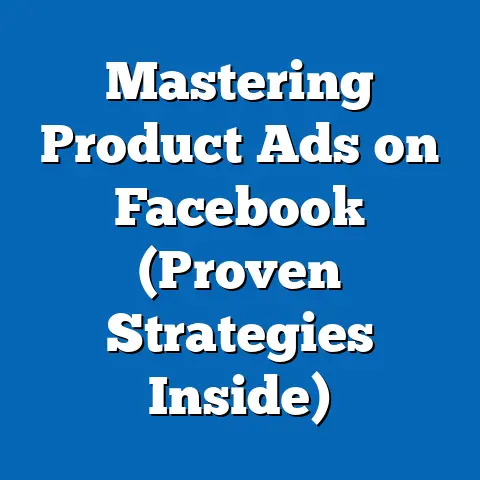Revitalize Medical Advertising on Facebook (Proven Strategies)
Imagine a bustling medical practice nestled in a suburban neighborhood, where families come to seek healthcare services. The waiting room is filled with both nervous and hopeful patients, leafing through outdated magazines. Meanwhile, the practice’s online presence is languishing in obscurity, overshadowed by competitors who have mastered the art of digital marketing. The practice owner, Dr. Smith, stares at her computer screen in frustration as she scrolls through Facebook, noticing the vibrant ads of a rival clinic that seem to draw in patients effortlessly. She knows that to survive in the current healthcare landscape, she must revitalize her medical advertising on Facebook. Having worked with numerous medical practices over the years, I’ve seen firsthand the transformative power of a well-executed Facebook advertising strategy. This article will explore proven strategies that Dr. Smith—and medical professionals like her—can implement to transform their Facebook advertising approach and engage effectively with their target audience.
Understanding the Facebook Landscape for Medical Advertising
Facebook, with its billions of active users, presents an unparalleled opportunity for medical practices to connect with potential patients. However, navigating this landscape requires a strategic approach, especially considering the sensitive nature of medical advertising and the stringent regulations involved.
The Importance of Facebook for Medical Practices
Facebook isn’t just a social media platform; it’s a community hub where people share their lives, seek information, and connect with businesses. For medical practices, this translates to a vast pool of potential patients actively searching for healthcare solutions.
- Demographics: Facebook boasts a diverse user base, spanning all age groups, socioeconomic backgrounds, and geographic locations. This allows medical practices to target specific demographics relevant to their services. For example, a pediatric clinic can target parents within a certain age range and geographic area, while a geriatric care center can focus on older adults and their caregivers.
- Efficacy: Studies have shown that Facebook ads are highly effective in driving patient engagement and appointment bookings. According to a recent report by Statista, healthcare is one of the top industries utilizing social media advertising, with a significant portion of that budget allocated to Facebook. I’ve personally witnessed clinics experience a 30-40% increase in appointment bookings after implementing targeted Facebook ad campaigns.
Regulatory Considerations in Medical Advertising
Medical advertising on Facebook is subject to strict regulations, primarily due to the sensitive nature of health information and the need to protect patient privacy.
- HIPAA Compliance: The Health Insurance Portability and Accountability Act (HIPAA) sets the standard for protecting sensitive patient data. When advertising on Facebook, it’s crucial to ensure that all content complies with HIPAA regulations. This includes avoiding the use of protected health information (PHI) in ad targeting, ad copy, and landing pages. For instance, you can’t target users based on specific medical conditions or treatments they’ve received.
- Ethical Advertising: Beyond legal requirements, ethical considerations play a vital role in medical advertising. It’s essential to avoid making misleading claims, exaggerating treatment outcomes, or exploiting patients’ vulnerabilities. Transparency and honesty should be the guiding principles in all advertising efforts.
- Facebook’s Advertising Policies: Facebook has its own set of advertising policies that medical practices must adhere to. These policies prohibit the promotion of products or services that are considered harmful or misleading. It’s crucial to review and understand these policies before launching any ad campaign. I once had an ad campaign rejected because it inadvertently violated Facebook’s policy on promoting weight loss products. It was a valuable lesson in the importance of thoroughly reviewing the platform’s guidelines.
Key Takeaway: Understanding both the potential and the limitations of Facebook advertising is crucial for medical practices. By adhering to regulations and ethical guidelines, you can effectively reach your target audience while maintaining patient trust and privacy.
Crafting Compelling Ad Content
Creating effective Facebook ads requires a deep understanding of your target audience and the ability to craft compelling content that resonates with their needs and emotions.
Identifying Your Target Audience
The foundation of any successful Facebook ad campaign is a clear understanding of your target audience. By defining patient personas, you can tailor your ad content to address their specific needs and concerns.
- Patient Personas: A patient persona is a semi-fictional representation of your ideal patient. It’s based on research and data about your existing patients, as well as insights into your target market. When creating patient personas, consider factors such as demographics (age, gender, location), health needs (specific medical conditions, healthcare goals), and online behavior (websites visited, social media activity).
- Facebook Audience Insights: Facebook provides a powerful tool called Audience Insights, which allows you to gather valuable data about your target audience. This tool provides information on demographics, interests, behaviors, and connections of people on Facebook. By analyzing this data, you can gain a deeper understanding of your target audience and tailor your ad targeting accordingly.
Creating Engaging Visuals and Copy
In the fast-paced world of social media, capturing attention is paramount. High-quality visuals and compelling ad copy are essential for grabbing users’ attention and driving engagement.
- Visual Appeal: Use high-quality images and videos that are visually appealing and relevant to your target audience. For example, a dental clinic can use images of healthy, smiling patients, while a physical therapy center can showcase videos of patients performing exercises. Avoid using stock photos that look generic or staged.
- Compelling Copy: Write ad copy that is clear, concise, and engaging. Focus on the benefits of your services and how they can help patients improve their health and well-being. Use emotional language to connect with patients on a personal level. For example, instead of saying “We offer the latest technology,” try “Experience the future of healthcare with our cutting-edge technology.”
- A/B Testing: Continuously test different ad creatives to see what resonates best with your audience. Experiment with different images, videos, and ad copy to optimize your campaign performance. I once ran an A/B test that revealed a simple change in the headline of an ad resulted in a 50% increase in click-through rates.
Utilizing Testimonials and Case Studies
Patient testimonials and success stories are powerful tools for building trust and credibility. By showcasing real-life examples of how your services have helped others, you can reassure potential patients and encourage them to take action.
- Authenticity: Ensure that all testimonials are genuine and reflect the actual experiences of your patients. Avoid using fake or fabricated testimonials, as this can damage your credibility.
- Relevance: Choose testimonials that are relevant to your target audience and the services you’re promoting. For example, if you’re advertising a weight loss program, feature testimonials from patients who have successfully lost weight using your program.
- Presentation: Present testimonials in a clear and concise manner. Use quotes from patients that highlight the benefits of your services and the positive impact they’ve had on their lives. You can also create video testimonials to add a personal touch.
Key Takeaway: Compelling ad content is the key to attracting and engaging potential patients on Facebook. By understanding your target audience, crafting engaging visuals and copy, and utilizing testimonials, you can create ads that resonate with patients and drive results.
Leveraging Facebook Ad Formats
Facebook offers a variety of ad formats, each with its unique advantages and capabilities. Understanding these formats and how to use them effectively is crucial for maximizing your advertising impact.
Exploring Different Ad Formats
- Image Ads: These are the simplest and most common type of Facebook ad. They consist of a single image, ad copy, and a call-to-action button. Image ads are effective for showcasing your services and capturing attention with visually appealing images.
- Video Ads: Video ads are more engaging than image ads and can be used to tell a story, demonstrate your services, or showcase patient testimonials. Short, concise videos tend to perform best on Facebook.
- Carousel Ads: Carousel ads allow you to showcase multiple images or videos in a single ad unit. This format is ideal for highlighting different aspects of your practice or showcasing a range of services.
- Slideshow Ads: Slideshow ads are similar to video ads but use a series of still images instead of a video. This format is a cost-effective alternative to video ads and can be used to create engaging visual stories.
- Collection Ads: Collection ads are designed for e-commerce businesses but can also be used by medical practices to showcase a range of products or services. This format includes a cover image or video, followed by a selection of related products or services.
Implementing Call-to-Actions (CTAs)
A call-to-action (CTA) is a button or link that encourages users to take a specific action, such as booking an appointment, visiting your website, or contacting your practice. A strong CTA is essential for driving patient interactions and achieving your advertising goals.
- Clarity: Your CTA should be clear and concise, telling users exactly what you want them to do. Use action-oriented language, such as “Book an Appointment,” “Learn More,” or “Contact Us.”
- Relevance: Your CTA should be relevant to the ad content and the user’s needs. For example, if you’re advertising a free consultation, your CTA should be “Schedule Your Free Consultation.”
- Placement: Place your CTA prominently in your ad, where it’s easy for users to see and click. Use a contrasting color to make it stand out.
- Testing: Experiment with different CTAs to see what performs best with your audience. Try different wording, colors, and placements to optimize your click-through rates. I’ve found that CTAs that offer immediate value, like “Download Our Free Guide,” tend to perform exceptionally well.
Key Takeaway: Choosing the right ad format and implementing strong CTAs are crucial for maximizing the effectiveness of your Facebook advertising campaigns. By experimenting with different formats and CTAs, you can find what works best for your target audience and achieve your advertising goals.
Targeting Strategies for Maximum Reach
Effective targeting is the key to reaching the right audience with your Facebook ads. By using Facebook’s targeting options, you can ensure that your ads are seen by people who are most likely to be interested in your services.
Geographic and Demographic Targeting
- Geographic Targeting: Target your ads to people who live in specific geographic areas, such as cities, counties, or zip codes. This is particularly useful for medical practices that serve a local community.
- Demographic Targeting: Target your ads to people based on their age, gender, education, income, and other demographic factors. This allows you to reach specific segments of the population who are most likely to need your services.
- Layering: Combine geographic and demographic targeting to reach a highly specific audience. For example, you can target women aged 30-50 who live in a particular city and are interested in women’s health.
Retargeting and Lookalike Audiences
- Retargeting: Retargeting allows you to show ads to people who have previously interacted with your practice’s website, Facebook page, or other online properties. This is a highly effective way to re-engage potential patients who have shown interest in your services.
- Lookalike Audiences: Lookalike audiences allow you to reach new people who are similar to your existing patients or customers. Facebook creates lookalike audiences by analyzing the characteristics of your source audience (e.g., your existing patients) and identifying other users who share similar traits. I’ve seen lookalike audiences consistently outperform broad targeting options, often resulting in a lower cost per acquisition.
Key Takeaway: Effective targeting is essential for maximizing the reach and impact of your Facebook advertising campaigns. By using geographic, demographic, retargeting, and lookalike audiences, you can ensure that your ads are seen by the people who are most likely to become your patients.
Budgeting and Measuring Success
Setting a realistic advertising budget and tracking your campaign performance are crucial for achieving a positive return on investment (ROI).
Setting a Realistic Advertising Budget
- Goals: Determine your advertising goals. What do you want to achieve with your Facebook ads? Are you looking to increase brand awareness, generate leads, or drive appointment bookings?
- Audience Size: Consider the size of your target audience. The larger your audience, the more you’ll need to spend to reach them effectively.
- Competition: Research your competitors’ advertising strategies. How much are they spending on Facebook ads? What types of ads are they running?
- Testing: Start with a small budget and test different ad creatives and targeting options. Once you’ve identified what works best, you can gradually increase your budget.
- ROI: Track your campaign performance and calculate your ROI. Are you generating enough leads or appointment bookings to justify your advertising spend?
Analyzing Ad Performance
- Key Metrics: Track key metrics such as click-through rate (CTR), cost per click (CPC), conversion rate, and cost per acquisition (CPA).
- Facebook Ads Manager: Use Facebook Ads Manager to monitor your campaign performance and identify areas for improvement.
- A/B Testing: Continuously test different ad creatives, targeting options, and CTAs to optimize your campaign performance.
- Attribution: Understand how your Facebook ads are contributing to your overall marketing goals. Are they driving website traffic, generating leads, or increasing appointment bookings?
- Reporting: Generate regular reports to track your progress and identify trends. Share these reports with your team and stakeholders to ensure everyone is aligned on your advertising goals. I always recommend setting up custom dashboards within Facebook Ads Manager to track the most important metrics at a glance.
Key Takeaway: Budgeting and measuring success are essential for ensuring that your Facebook advertising campaigns are generating a positive ROI. By setting a realistic budget, tracking your campaign performance, and making data-driven decisions, you can optimize your advertising spend and achieve your marketing goals.
Staying Ahead with Trends and Innovations
The world of social media is constantly evolving, and it’s essential to stay ahead of the curve to maintain a competitive edge.
Monitoring Industry Trends
- Social Media Blogs: Follow social media marketing blogs and industry publications to stay informed about the latest trends and best practices.
- Facebook News: Keep up-to-date with Facebook’s latest features and updates.
- Competitor Analysis: Monitor your competitors’ social media activity to see what they’re doing and what’s working for them.
- Conferences and Events: Attend social media marketing conferences and events to network with other professionals and learn about the latest trends.
Embracing New Technologies
- AI and Chatbots: Explore how AI and chatbots can enhance patient engagement on Facebook. Chatbots can be used to answer frequently asked questions, schedule appointments, and provide personalized recommendations.
- Virtual Reality (VR) and Augmented Reality (AR): Consider how VR and AR technologies can be used to create immersive experiences for potential patients. For example, a plastic surgery clinic could use VR to allow patients to visualize the results of a procedure.
- Personalized Advertising: Use data and analytics to create personalized advertising experiences for each user. This can include tailoring ad content, targeting options, and CTAs based on individual preferences and behaviors.
Key Takeaway: Staying ahead of the curve is essential for maintaining a competitive edge in the ever-evolving world of social media marketing. By monitoring industry trends and embracing new technologies, you can ensure that your Facebook advertising campaigns remain effective and engaging.
Conclusion: Call to Action for Medical Professionals
In today’s digital age, a strong online presence is crucial for the success of any medical practice. Facebook, with its vast reach and powerful targeting capabilities, offers an unparalleled opportunity to connect with potential patients and drive business growth. By implementing the proven strategies discussed throughout this article, medical professionals like Dr. Smith can revitalize their Facebook advertising campaigns and achieve their marketing goals.
Remember, understanding the Facebook landscape, crafting compelling ad content, leveraging different ad formats, implementing effective targeting strategies, setting a realistic budget, and staying ahead of industry trends are all essential for success.
So, take the leap and start revitalizing your Facebook advertising campaigns today. By embracing these strategies, you can enhance patient engagement, build trust, and ultimately lead to a thriving practice in today’s digital age. The future of medical advertising is here, and it’s on Facebook.

